
Contents





Consilience






Incheon, a City
Transformed Over Time
Charms of the Old and New
Home to Incheon International Airport, the port metropolis of Incheon has naturally become a destination city for visitors to Korea. The city accounts for 100th of the total land area of the country, making it technically the largest city in Korea in terms of square kilometers. While its beautiful islands and beaches are a sight to behold, this trip looks into the nooks and crannies of the city itself.
Written by Samuel Kim Photographed by Studio Kenn
Illustrated by Hagogo
Baedari Secondhand Bookstore Alley,
Finding Value in the Old
A sign hanging in front of an old store reads “Sell Your Books Here.” I push open the sliding door, and find an entire wall of used books. The distinctive scent of aged paper tickles my nose. Secondhand bookstores like this may soon be harder to find in Korea. The Baedari Alley was once filled with more than forty bookstores specializing in secondhand books, but only a handful remain today.
Secondhand bookstores thrived in the days when students sold reference books at giveaway prices toward the end of each semester. With paper books losing their place in the modern world and more readers turning to online stores, secondhand bookstores have quickly dwindled in number. Nevertheless, the few bookstores still existing today serve as cultural spaces rather than places that simply sell books. Local residents gather in bookstores to read poetry and hold workshops. The bookstores have connected the community through a common love of books.
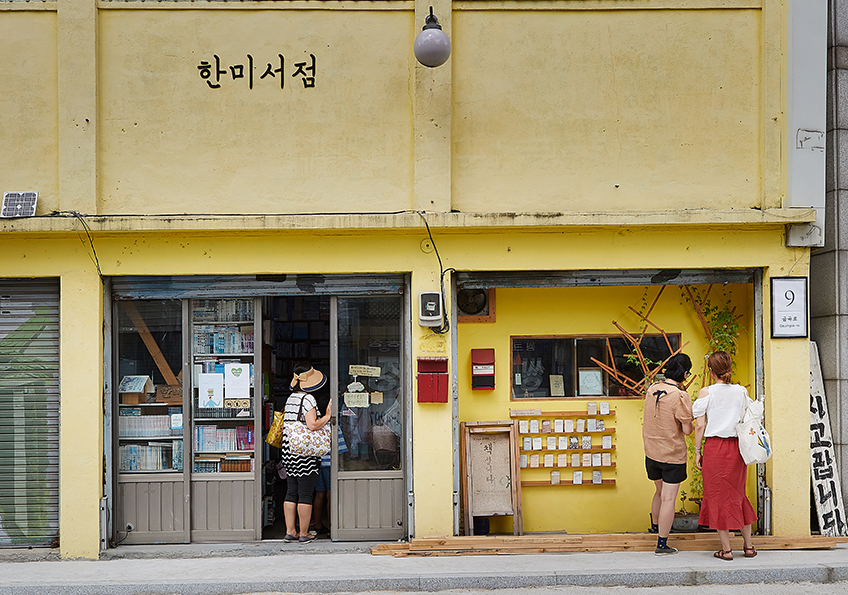 A few bookstores still existing today serve as cultural spaces rather than places that simply sell books.
A few bookstores still existing today serve as cultural spaces rather than places that simply sell books.The bookshelves in the small, old stores are similar to the gritty alleys. We don’t know when exactly they will disappear, but it is meaningful to keep watch while they slowly fade away. A book from the Baedaeri Secondhand Bookstore Alley, the symbol of the old city center, may be the perfect souvenir to take back home.
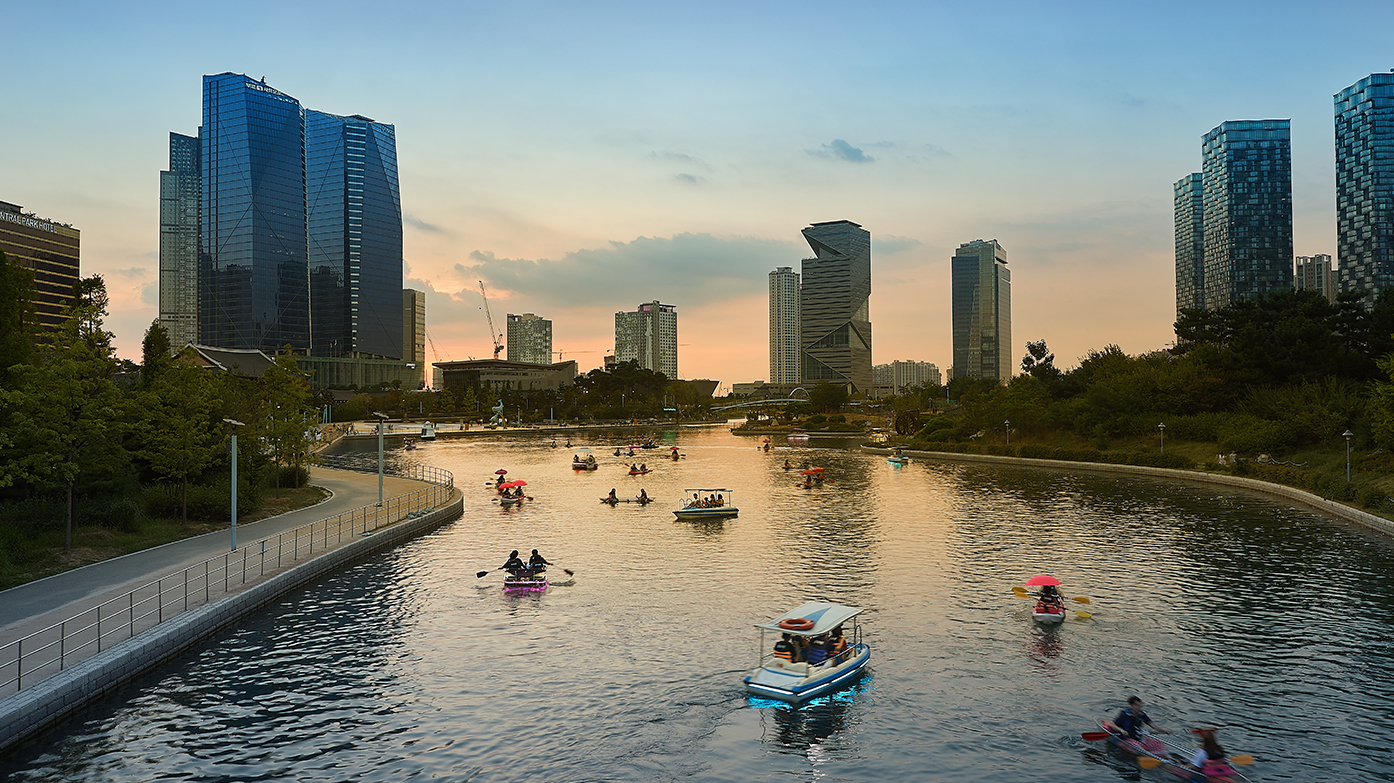 The lake in Songdo Central Park allows people to enjoy boat riding or kayaking in the middle of the city.
The lake in Songdo Central Park allows people to enjoy boat riding or kayaking in the middle of the city.Songdo Central Park,
Art Amid a Forest of Buildings
The new city center is filled with all things slick and shiny. The streets are neatly lined with skyscrapers of the same height, and low slopes add a splash of green to what may otherwise have been a dull forest of buildings. Many people are taking a break in the shade of trees or strolling along the lake. As the sun starts to go down, the kayaks and boats bobbing on the lake become decorated in a rainbow of lights. The buskers by the lake and those watching their performances don’t seem bothered that it is getting dark.
A green paradise that is 56 times the size of a soccer field, the park features neofuturistic buildings and art installations. The Tri-Bowl, which combines the word “triple” and “bowl,” is a cultural complex shaped like a seashell or, from another angle, an upsidedown mountain. The unique structure, with its surface providing a reflection of the surrounding waters, creates an illusion that it’s floating.
Over time, this well-planned urban park will be of greater value than any of the surrounding buildings.
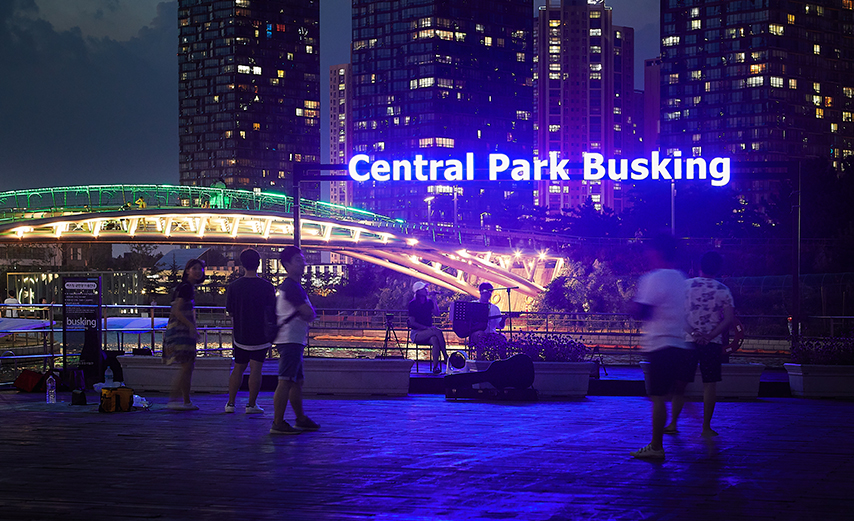 People pause in their way and enjoy the busking without noticing the sun already went down.
People pause in their way and enjoy the busking without noticing the sun already went down.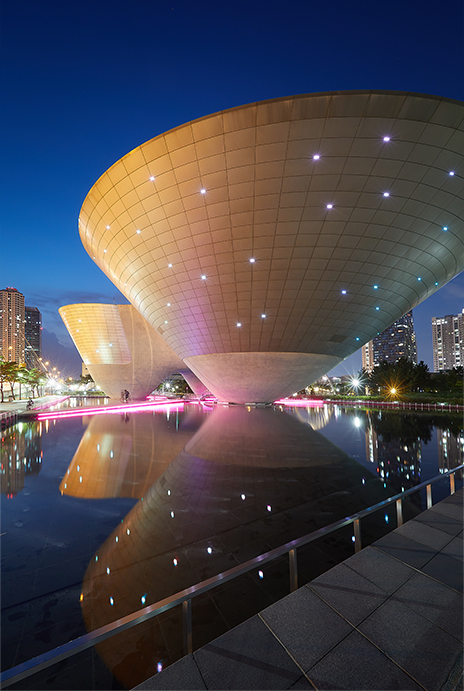 The unique structure of Tri-Bowl, with its surface providing a reflection of the surrounding waters, creates an illusion that it’s floating.
The unique structure of Tri-Bowl, with its surface providing a reflection of the surrounding waters, creates an illusion that it’s floating.Sorae Ecology Park,
Salt Field Restored Into Vibrant Park
A vast park spanning 1,560,000 square kilometers lies not too far from the city center. It is a harmonious ensemble of mud flats, salt fields and grasslands. The mud flat nearest to the entrance is covered with holes, with mud crabs crawling in and out. Visitors can enjoy a panoramic view from the observation deck, or take off their shoes to step in the mud. A popular destination for family outings, the park surrounds you with the laughter of children.
Deeper in the park is the Nature Learning Center that used to be an actual salt field. Here, you can watch and learn how salt is produced. As you step on a bridge over the salt field, you will be impressed by the view of the water mirroring the clear blue sky. Prepare your camera before arriving at this photo spot as you will not want to miss the pictureperfect surroundings.
 Windmills move slowly in the middle of the field.
Windmills move slowly in the middle of the field.The trail weaves in and out of a reed forest, and eventually leads to the center of the park. The trills and chirps of insects form a summer symphony. Ants small and large are scurrying about on the ground, while birds are soaring up above. A few wind turbines, with their slowly turning blades, are standing tall in the middle of the grassland. This is undoubtedly the best trail in Incheon.
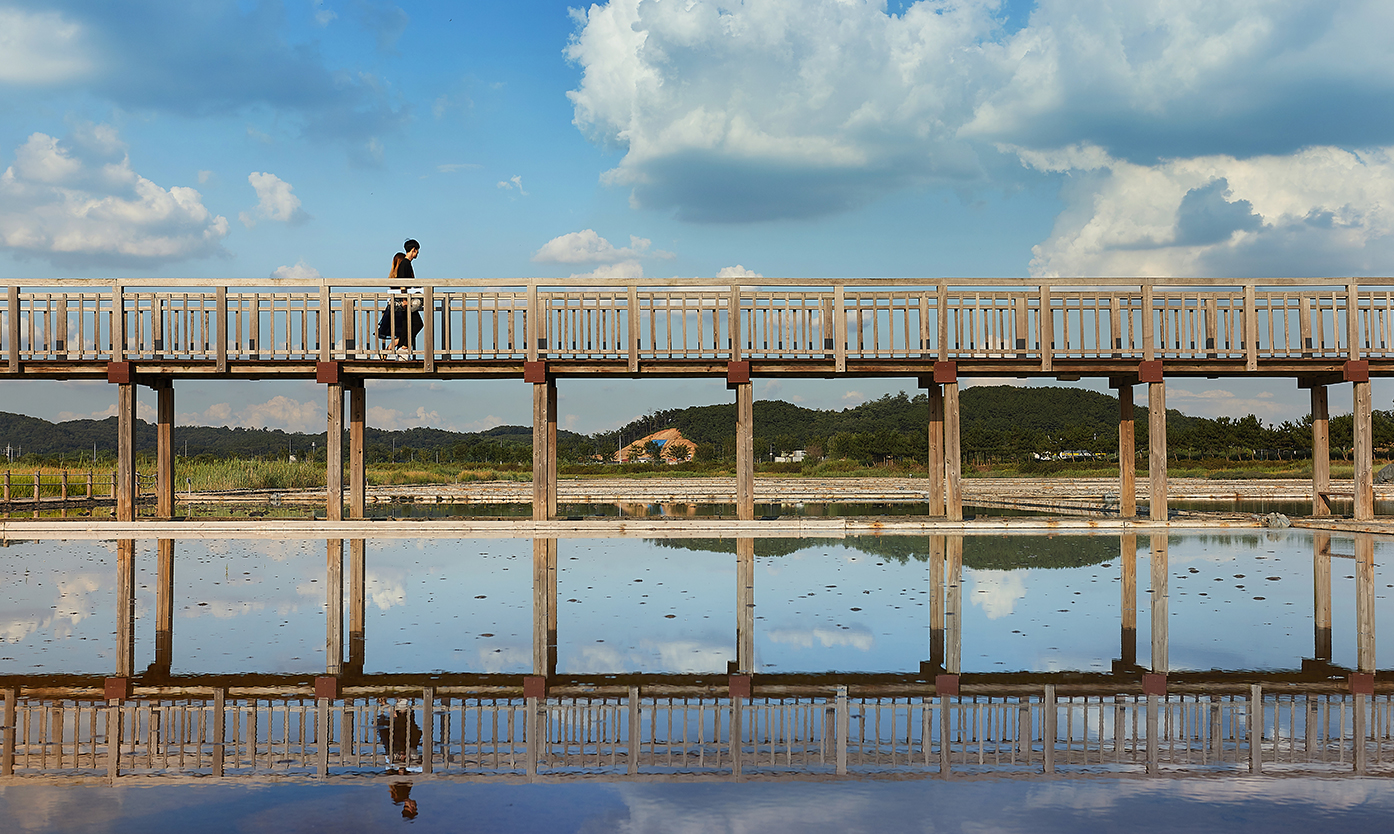 Sorae Ecology Park is a harmonious ensemble of mud flats, salt fields, and grasslands.
Sorae Ecology Park is a harmonious ensemble of mud flats, salt fields, and grasslands.Trip Points
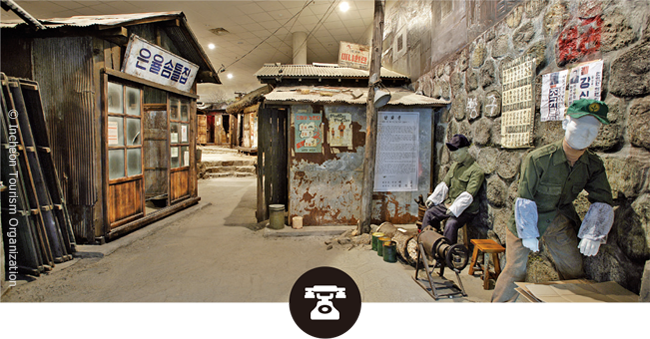
Sudoguksan Museum of Housing & Living,
Memories of a Poverty-Stricken Past
Take a journey back to the Korea of a half-century ago. Built by villagers and social organizations in 2001 when the hillside village was facing redevelopment, the museum features reproductions of the lives of the poor in the olden days of the 1960s. The museum’s artifacts, donated by the villagers themselves, hold great historical and cultural significance.
The main theme of the exhibition hall is “living together.” The village was located on a steep slope and had narrow, winding alleys. The houses were cramped and the villagers had to use communal toilets. Despite being poor, they felt a strong sense of community, and their lives were blessed with a neighborly warmth.
A visit to the museum will reveal a side of Korea that has long been forgotten. You get to travel back in time to a nostalgic era and experience life in a hillside village.
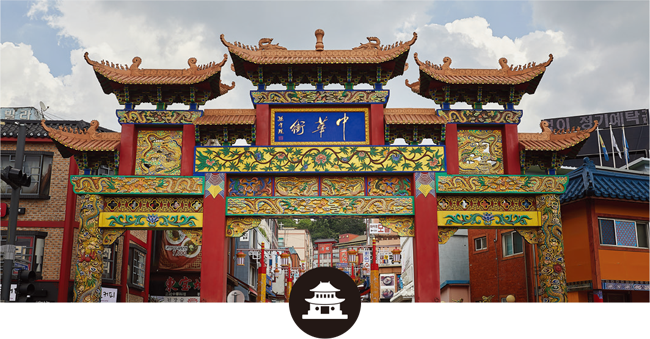
Wolmido & Incheon Chinatown,
Things to See, Do and Taste
Wolmido used to be an island, and the name “wolmi” literally means “the tail of a half moon.” A new highway has made it part of the mainland. A popular attraction is the Wolmi Theme Park that has a Ferris wheel rising 115 meters above the waters of the Yellow Sea. The theme park lights up at night and the view from the top of the Ferris wheel becomes even more spectacular. In Wolmido, time will fly by with so many rides to enjoy.
A few minutes away from Wolmido is Incheon’s Chinatown. The bold red gate to Chinatown is hard to miss. You can fill up your belly with a bowl of jajangmyeon noodles in a black bean sauce, or try some delicious snacks like candied strawberries and dragon’s beard candy. If you have more time to spare, walk down the hill to visit the Incheon Art Platform and the Sinpo International Market. The attractions of the old city center are conveniently close to each other, yet distinct in their own way.
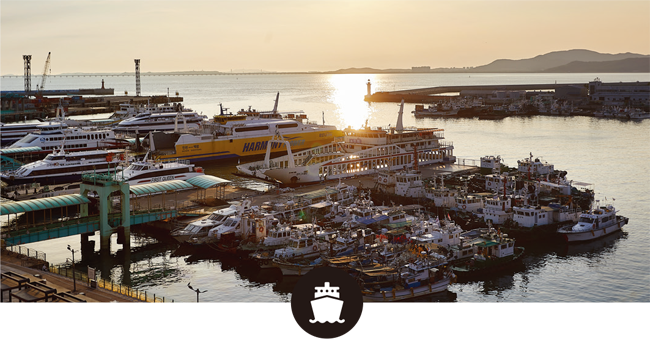
Yeonanbudu Pier,
Where Ships Gather to Sleep
I stand on the pier, and take in a whiff of the sea air. There are young couples taking pictures in front of the matryoshka dolls, and children splashing about in a small water park. Along the waterfront, I see dozens of ships anchored side by side. They are mostly small cruise ships and fishing boats for tourists.
Some of the ships are humorously named, while others have pure Korean names that are not based on Chinese characters. The observation deck on the seventh floor offers a good view of the entire pier. If you prefer a more outdoorsy experience, head to the stairway on the sixth floor to feel the sea breeze against your cheeks.
Right next to the pier is the Incheon Fish Market. Here, you can buy fresh seafood at affordable prices and pay a small table-setting fee to have them immediately prepared for your meal. It’s a must-visit for seafood lovers.

Jeongseojin, Sunset at the Western End
of Gwanghwamun Gate
Jeongseojin is the counterpart to Jeongdongjin, the best sunrise spot in Korea. Jeongdongjin and Jeongseojin lie, theoretically, at the far eastern and western ends of Gwanghwamun Gate in central Seoul. A local myth is that a young scholar who was on his way to the capital to sit for the state exam professed his love to an innkeeper’s daughter while watching the sunset at Jeongseojin.
Noeuljong, a pebble-shaped sculpture is easily noticeable even from a distance. The exterior is asymmetrically curved, and a bell hangs within. The view of the sunset through the sculpture is truly mesmerizing. Even after the sun has set, you will want to stay on to watch how the sculpture changes in color.
The Ara Tower next to Noeuljong is highly recommended, especially if you’re traveling with your loved ones. Visit the observatory on the 23rd floor for a breathtaking view of the sea at dusk.
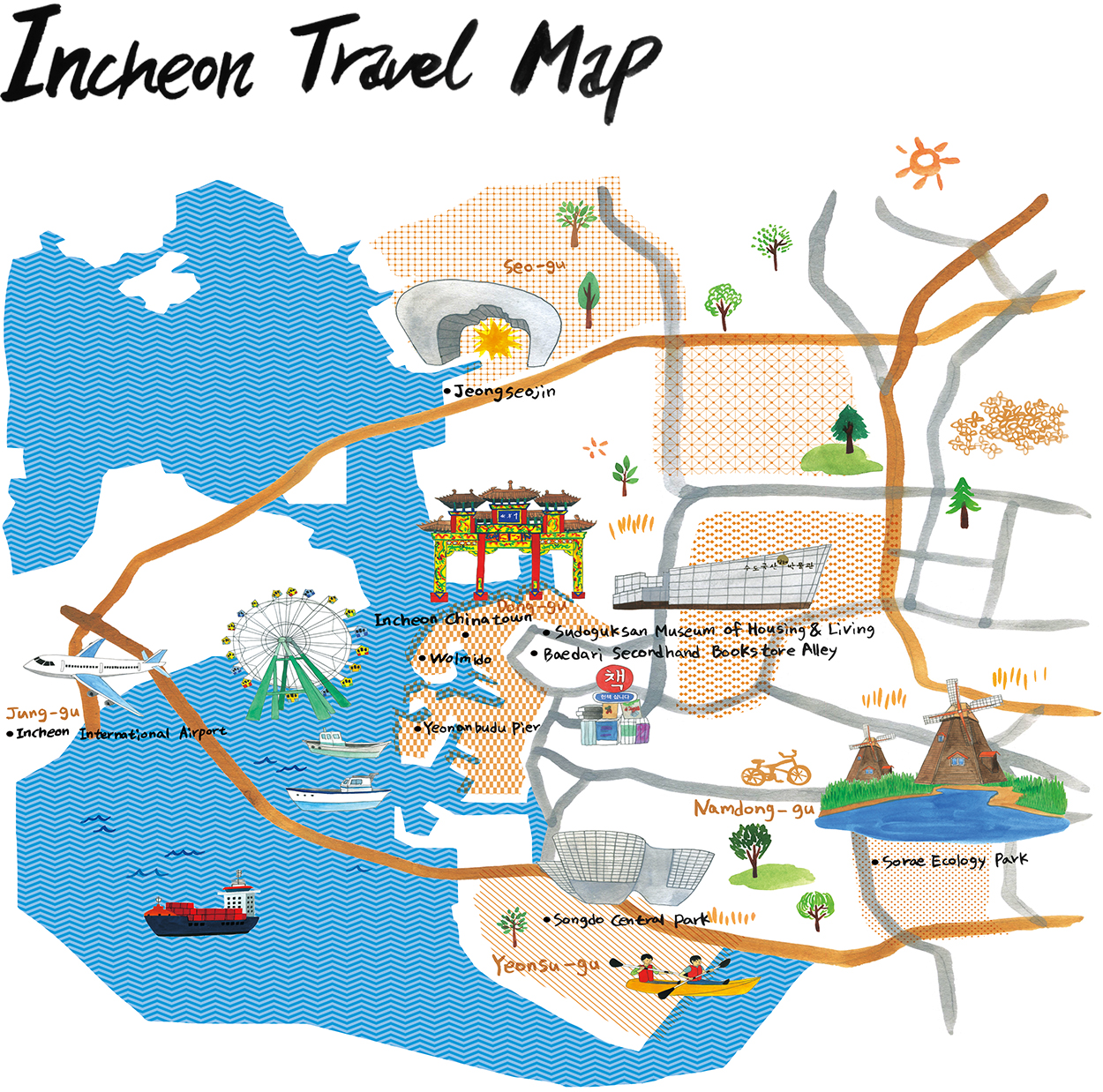
Travel Tip
-
Tourism Information
- Incheon Tour
- Tel: +82-32-120
- Korean, English, Japanese, Chinese available
- Incheon Tourism Organization
- Tel: +82-32-899-7300
- Korean, English, Japanese, Chinese available
- Incheon Tour
-
Korea Travel Hotline
- Tel: +82-1330
Incheon Tourist Information Center
- Address: 234, Incheon tower-daero, Yeonsu-gu, Incheon
- Tel: +82-32-832-3031
Hours: 09:00-18:00Jeongseojin
- Address: 41, Jeongseojin 1-ro, Seo-gu, Incheon
Sudoguksan Museum of Housing & Living
- Address: 51, Solbit-ro, Dong-gu, Incheon
- Tel: +82-32-770-6131
- Hours: 09:00-18:00Baedari Secondhand Bookstore Alley
- Address: 18-10, Geumgok-ro, Dong-gu, Incheon
-
Incheon Chinatown
- Address: 266, Jemullyang-ro, Jung-gu, Incheon
Wolmi Theme Park
- Address: 81, Wolmimunhwa-ro, Jung-gu, Incheon
- Tel: +82-32-761-0997
- Hours: Weekdays 10:00-22:00, Weekends 10:00-24:00Yeonanbudu Pier
- Address: 36, Yeonanbudu-ro, Jung-gu, Incheon
Incheon Fish Market
- Address: 37, Yeonanbudu-ro 33beon-gil, Jung-gu, Incheon
- Hours: 05:00-21:00Sorae Ecology Park
- Address: 77, Sorae-ro 154beon-gil, Namdong-gu, Incheon
- Tel: +82-32-435-7076
Other Articles





Consilience





Application of subscription
Sign upReaders’ Comments
GoThe event winners
Go


 September 2018
September 2018


